Topo map showing Lewis Franklin Wilhite property. I put a black box where the homestead was marked in the 1904 Plat Map. This location is now in public ownership as a greenbelt. Although overgrowing, the foundation of the home is still there.
Willhite Homestead (Verdigris Valley)
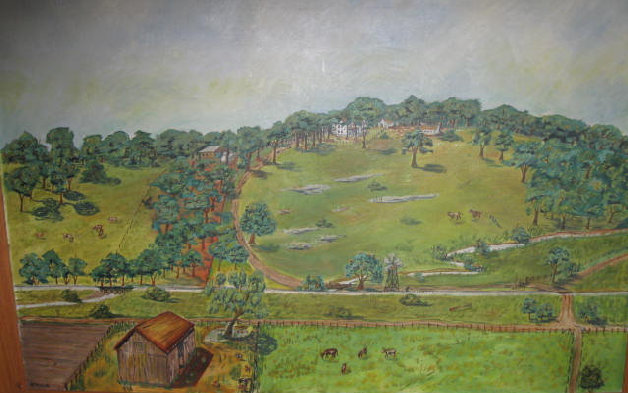
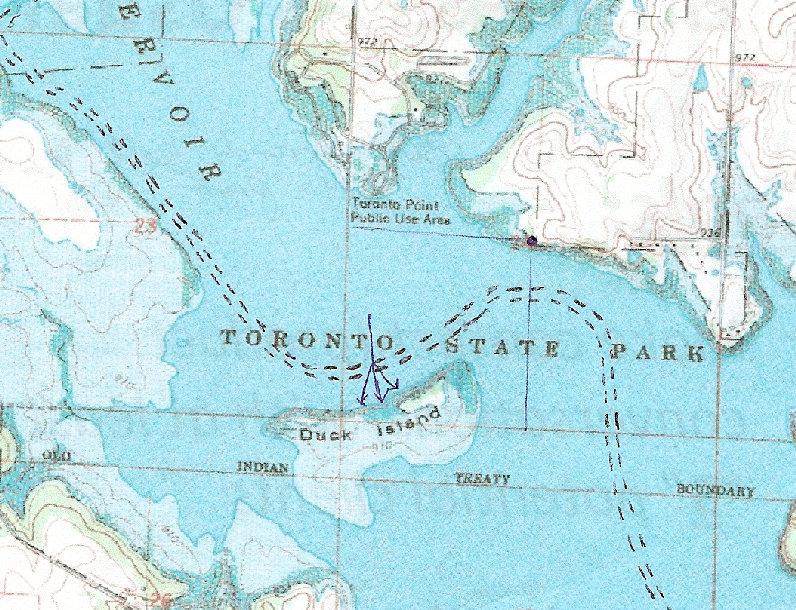
Section 24
SW 1/4
NE 1/4
NW 1/4
SE 1/4
Original channel of Verdigris River as mapped from 1887 Kansas State Atlas
A Willhite homestead picture drawn by Gordon Dean Willhite, son of James Leo, son of Lewis Franklin Wilhite
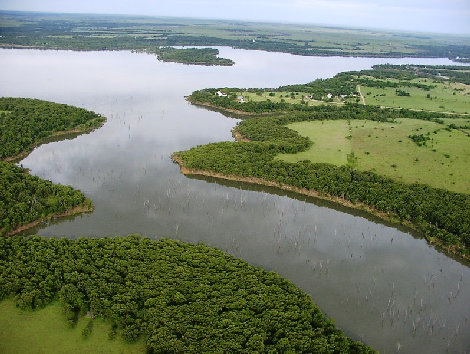
Duck Island
Toronto Reservoir
A few months later, Elizabeth purchased or inherited 160 acres of land adjacent to the property she just sold. This 160 acres was originally granted to Robert Wear for serving in the War of 1812 in the Ohio Militia under Captain Sheets. His widowed wife Catharine Wear and Elizabeth Wilhite are on the granted Land Bounty from the government. It is unclear what the relation was between Catharine and Elizabeth. It could be possible that Elizabeth is Robert and Catharine Wears child but she is not listed in the will or any other documentation, but Elizabeths birth year between 1815-1819 matches perfectly. Many Wilhites and Jones settled on that 160 acres of land for many generations until the Toronto Reservoir drove them out. Below is a link to the land grant. Be sure to click "Document Image" to see it. Note it is signed by Abraham Lincoln! via his secretary. (By 1904, this 160 acres had been sold outside the family)
SE 1/4 (160 Acres) from Robert Wear
First Cabin by Julius Wilhite
On April 27, 1861 Elizabeth Wilhite sold this tract of land to John N. Walkup for $65.67.
Land sold to John N. Walkup
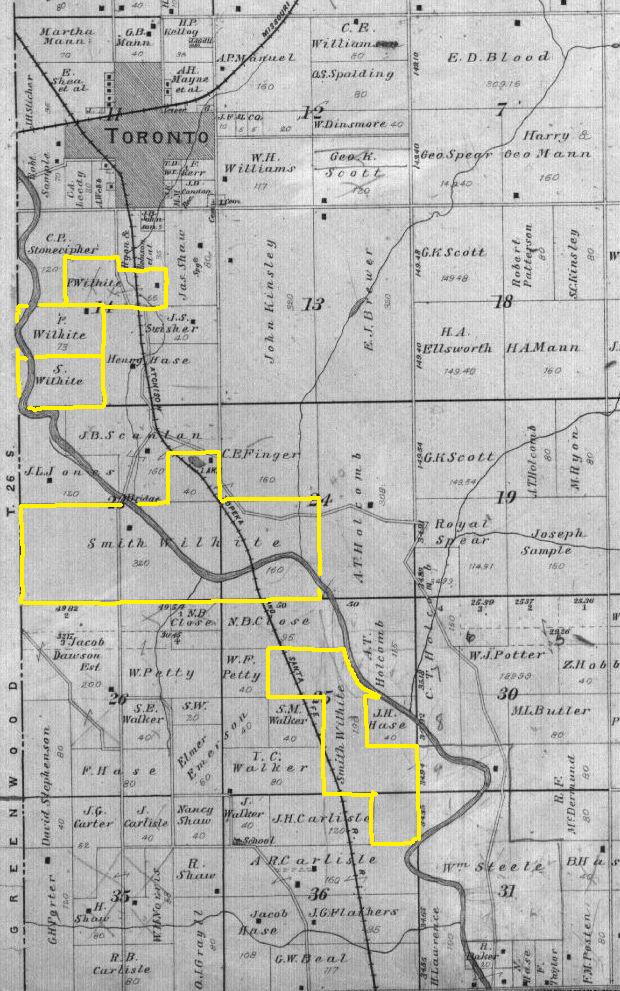
By 1904, Smith Wilhite owned a considerable amount of land in the Toronto Area of Kansas.
Smith Willhites second son Lewis Franklin Wilhite settled this plot of land and 2 more generations, James Leo and Gordon Dean were born here as well before the Toronto Lake Reservoir covered all the property west of the railroad tracks.
Along the backside of the road is the railroad tracks as well as a stream. The plat map above shows both on the property as well as the homestead house which is shown as a small black square on plat maps.
A = Duck Island location
Smith Wilhites first son William H. Willhite married Jacob Dawsons daughter Anna R. Dawson.
Smith Wilhite had 3 children who married Jones.
Smith Wilhites daughter Jennie Wilhite married a Scanton.
Toronto Cemetery
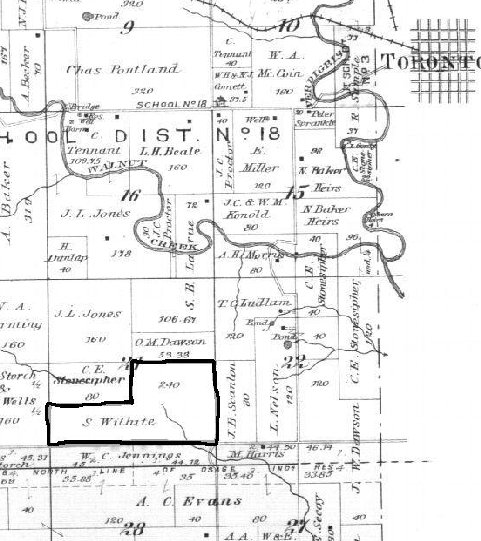
1904 Woodson County Plat Map
Smith Wilhite also owned another 240 acres to the west in Greenwood County
Other Wilhite properties
are here
A
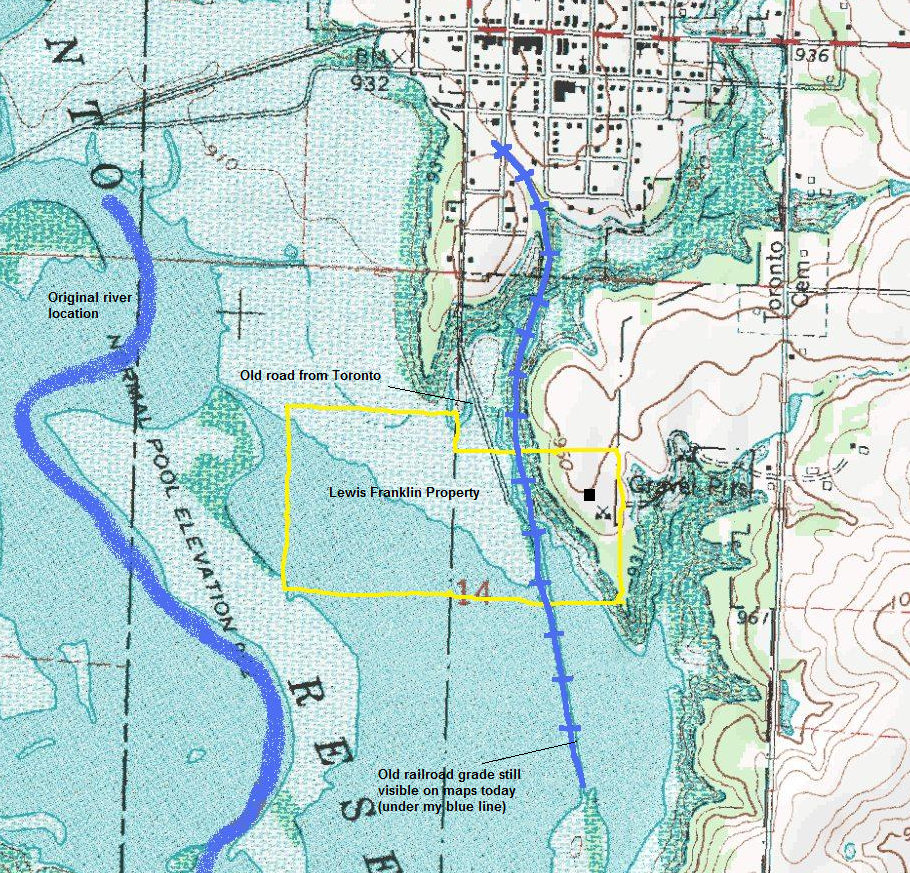
Sometime around 1858 or 1859, Julius, Elizabeth and the three youngest children moved to the Verdigris Valley near Toronto, in the Kansas Territory. It would still be a few years before Kansas became a state as the name Kansas only started appearing on maps 4 years prior. This move put them on the edge of the frontier again, as true homesteaders arriving before the government had even opened the area for settlement. The first white settlers started arriving only 3 years before. Officially, it was still land promised to the New York Indians but they weren't using it. Although a frontier area, it's still recorded that in 1860, three of the sons (John, Lewis and Henry) had all attended school that year in Kansas.
1860 Julius Dies
Within a year or two of the arrival of the family in Kansas, Julius died suddenly from apoplexy in April of 1860 at the age of 63. Government death records show that Julius also went by Ruphus or Rufus. Julius was buried in the Cedar Bluff Cemetery just north of Toronto, Kansas. The second oldest son Smith who came to Kansas a few years before the rest of the family had rejoined his family and became the head of the home at age 22. He went on to take care of his widowed mother and younger 3 brothers. We know from a journal of a passerby that Smith was running a grocery market about a half mile from the homestead.
1861-1875 Wilhite Land Acquisitions
Shortly after Julius died, Elizabeth sold the original homestead location in 1861. It was a cabin on a high timber bluff above the Verdigris River with 15 acres. The property wasn't good for farming. A few months later, Elizabeth purchased or inherited 160 acres of land adjacent to the property she had just sold. This 160 acres was originally granted to Robert Wear for serving in the War of 1812 in the Ohio Militia under Captain Sheets. His widowed wife Catharine Wear and Elizabeth Wilhite are on the granted Land Bounty from the government. It is unclear what the relation was between Catharine and Elizabeth. It could be possible that Elizabeth is Robert and Catharine Wears child but Elizabeth is not listed in Catharine Wears Will as a child or any other documentation, but Elizabeth's birth year between 1815-1819 matches perfectly for when the Wears were having children.
By 1904, this 160 acres had been sold outside the family. In the meantime, Smith Wilhite had acquired hundreds of other acres in the Verdigris Valley. All land was prime farming lands along the Verdigris River valley bottom. Smith Wilhite had become one of the largest land owners in the south Toronto area. His two remaining brothers, Lewis and Henry Wilhite stuck around helping on the family farm for several years after their father Julius died but soon, Lewis, Henry and even Elizabeth disappear.
161 acres of fenced land
244 acres of non-fenced land
4000 dollars on farm ?
100 dollars of farming implements
200 dollars amount of wages paid during year including board
160 roles of stone for fences
300 roles of rail fences
125 acres sown in fall of 1874
Unreadable acres of corn as well as Irish potatoes
400 pounds of butter made in the family
120 horses
5 milk cows
76 other cattle
10 swine
150 dollars worth of animals slaughtered or sold for slaughter
3 acres in Orchards
The 1875 Kansas census reveals all kinds of interesting things about the Smith Wilhite homestead.
After her husband Julius died, she remained around her children for at least 5 years. A census in 1865 shows her living with her son Smith who is now married with a newborn daughter. She also probably stayed there because her two youngest children Lewis and Henry were also working on the property. Then she vanishes. If she did die before the next census, that puts it between 1865 & 1870. She would be one of the many unknown graves in the Cedar Bluff Cemetery.
Elizabeth Last Years
At this time, it's unclear what happened to Lewis. The last we know, he was living with his brothers family and mom in 1860 at age 13, attending school. It's interesting to note that only the three youngest children of Julius and Elizabeth had the ability to read and write in the family. Probably because they were able to attend the first school in the county in the nearby town of Humboldt. The 1860 census shows them living closer to that location, probably so they could attend. It's likely Lewis could have enlisted in the Civil War like his older brother John but he would have been quite young age 14 to 17ish. I have found two Lewis Wilhite's who served in the Civil War out of Missouri but I haven't been able to prove or disprove they were our Lewis Wilhite.
Lewis Wilhite
1861 Civil War & John W. Wilhite
Although not near the battles of the Civil War, Kansas was still asked to supply several regiments to fight for the Union. The first and third sons of Julius and Elizabeth answered the call and enlisted. John W. Wilhite became a Private on August 13, 1861 at the age of 18. He served in the Tenth Regiment Kansas Volunteers Infantry, company C. After 2 years of service, he re-enlisted for another year and transferred to company A. John mustered out on 14 Aug 1865 at Montgomery Alabama. This was only 2 months before the end of his units service and one source conflicts saying he deserted out of the unit. According to the report of the Adjutant General of the State of Kansas he mustered out. Three years later, on March 10, 1868 he died. We know of his death thanks to government records and because of his gravestone erected by the government. The government burial card just says "Toronto" for Johns burial site. John W Wilhite was buried next to his father Julius in the Cedar Bluff Cemetery just north of Toronto, Kansas. They were the first Willhites to die in Toronto before the Toronto Cemetery was used in later years. It is likely John W Wilhite spent the 3 years after the war in the Toronto area with his brother Smith and the rest of his family. Just 2 months prior to him leaving the army, in June 1865, he was working on the farm in Toronto with his brothers and mom. He reported to the census taker that he was a farmer and a soldier, giving his regiment and company on that census record.
Unlike his next two brothers who helped out on the family farm and stuck around, he married in Missouri and wasn't around the family farm.
Joseph Wilhite
Henry Wilhite
As the youngest, Henry was still only 16 years old in 1865 living with his brother Smith's family and his widowed mom. In 1870 he was 21 and a laborer living at a neighbors home, the John T. Dazey family. Five years later he was back living with Smith's family working on the family farm as a laborer single at the age of 26. He disappears from the Toronto area after this. In 1910, a single 61 year old man fits his profile in Elkhorn, San Joaquin, California. I'm still trying to find out what happened to him.
WillhiteWeb - Family History





